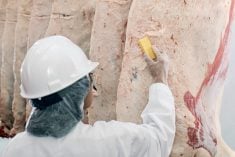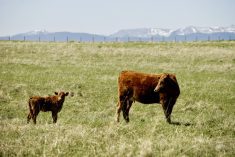Calving season is well underway and I am feeling very optimistic about the future. Prices, which seem to reach new market highs for all classes of cattle each week, are part of the reason. A global shortage of beef, largely due to prolonged and widespread drought, has pushed the U.S. cattle herd to a 50-year low and last year saw Australia report a record slaughter as producers liquidated their herds.
The beef supply may be constricted but globally the demand for beef has not ceased. In North America there is excellent demand for muscle cuts and unprecedented demand for ground beef. New gourmet hamburger chains are popping up throughout Canada and the U.S. and every top restaurant and five-star hotel seem to now offer a $25 hamburger on the menu. This has helped push cow prices close to AAA prices and helps with the short-term outlook.
Read Also

What to know before you go to Agribition 2025
If you’re attending Agribition 2025, this is the place to find out about tickets, dates and what’s happening this year.
There are other opportunities that await producers that will take a little longer to be fully realized. For instance, the combination of the 38.5 per cent tariff in Japan and safeguard trigger (tariff increases to 50 per cent if imports increase beyond a set formula) has impacted importers’ ability to significantly increase their purchases of Canadian beef. I know that increasing the supply of Canadian beef in Japan is of big interest to importers. On a recent trip to Asia, Japanese importers indicated they would like a second supply of grain-fed beef to augment the supply out of the U.S. The CCA’s objective is that Canada negotiate the elimination of both the tariff and the safeguard trigger in a bilateral agreement between Canada and Japan or the Trans-Pacific Partnership (TPP). There are strengthening signs that the U.S. and Japan are coming closer to agreeing to terms in a TPP deal. It’s essential that Canada do whatever is necessary to be part of that deal and secure the same terms of access.
- More ‘CCA Reports’ with Dave Solverson: COOL decision set for May
China, South Korea and the European Union (EU) are also important markets. Canadian beef exports to China have grown rapidly since 2012. Chinese demand for beef has outpaced what they’re able to produce domestically and forecasts predict China could double its annual global imports of beef before the end of this decade.
The Canada-Korea Free Trade Agreement came into effect on January 1. Korea is a big importer of beef and its preference for highly marbled grain-fed beef holds promise for Canada. Of course, we are waiting for Korea and a few others to resume imports following their temporary restrictions related to February’s BSE case. We are fortunate that the continuing strong global demand for beef has mitigated any negative market impact. Shipments to China are on their way again and I am optimistic that Korea and the others will be back again soon.
The Canada-EU Comprehensive Economic and Trade Agreement (CETA) is another potential game changer. Canada’s beef producers already have some small quota access to the EU but it’s underutilized because of onerous technical meat-processing conditions. Addressing these processing conditions is the key to whether Canadian packers will be interested in buying cattle raised according to EU protocols. The CCA has documents on its website to advise producers and feedlot operators how to ensure their cattle qualify to produce beef eligible for the EU and I encourage you to familiarize yourselves with the requirements.
These opportunities are the result of the Government of Canada’s aggressive trade agenda. Exports are the lifeblood of Canada’s beef industry; to maximize the value of every animal produced, Canada must have access to the world so we can sell each part of the animal to the market willing to pay the most for it.
Add the Canadian Beef Advantage to the trade achievements and the result is an excellent long-term outlook for Canada’s beef industry. This rosy outlook is not without significant threats including infrastructure and labour challenges. A strategy is needed to get more workers into agriculture and meat processing to ensure Canada can take full advantage of the trade agreements and market access government and industry have worked so hard to achieve.
I am also waiting with interest for May 18, when the World Trade Organization (WTO) Appellate Body is expected to release its decision on the U.S.’s mandatory country-of-origin labelling (COOL). The CCA fully expects that the WTO will again rule in Canada’s favour and deliver a final decision that is consistent with its three previous rulings.
This appeal is the U.S.’s final procedural option before Canada can request WTO authorization to retaliate. The Government of Canada has made it clear that it will impose duties on a targeted list of goods if the U.S. does not comply with its international trade obligations. Following the final ruling, there will be a few months while the retaliation amount is arbitrated before the governments of Canada and Mexico can bring duties that would come into effect.
The CCA will continue its efforts in Washington, D.C., to advocate for a resolution that genuinely resolves the problem of COOL by eliminating the need for U.S. livestock buyers to segregate imported animals from U.S.-born animals.
I for one will be very pleased when COOL is remedied appropriately once and for all.
















